Differences in Air and Sea Surface Temperatures in the Northern and Southern Part of the Adriatic Sea
Abstract
:1. Introduction
2. Materials and Methods
2.1. Description of Locations
2.2. Data and Methods Used
3. Results and Discussion
3.1. Analysis of Characteristic Annual Air Temperatures
3.2. Analysis of the Mean Monthly Air Temperatures
3.3. Analysis of the Mean Daily Air Temperatures
3.4. Analysis of the Mean Annual, Monthly and Daily Sea Surface Temperatures
3.5. Analysis of the Relationship between the Mean Monthly and Daily Air Temperatures and Sea Surface Temperatures
4. Conclusions
Author Contributions
Funding
Institutional Review Board Statement
Informed Consent Statement
Data Availability Statement
Conflicts of Interest
References
- Moatti, J.-P.; Thiébault, S. The Mediterranean Region under Climate Change. A Scientific Update: Abridged English/French Version; Allenvi: Marseille, France, 2016. [Google Scholar]
- Coll, M.; Piroddi, C.; Steenbeek, J.; Kaschner, K.; Ben Rais Lasram, F.; Aguzzi, J.; Ballesteros, E.; Bianchi, C.N.; Corbera, J.; Dailianis, T.; et al. The Biodiversity of the Mediterranean Sea: Estimates, Patterns, and Threats. PLoS ONE 2010, 5, e11842. [Google Scholar] [CrossRef] [Green Version]
- Pascual, M.; Rives, B.; Schunter, C.; Macpherson, E. Impact of life history traits on gene flow: A multispecies systematic review across oceanographic barriers in the Mediterranean Sea. PLoS ONE 2017, 12, e0176419. [Google Scholar] [CrossRef] [PubMed]
- Bouzinac, C.; Font, J.; Johannessen, J. Annual cycles of sea level and sea surface temperature in the western Mediterranean Sea. J. Geophys. Res. Earth Surf. 2003, 108, 1–20. [Google Scholar] [CrossRef] [Green Version]
- Maiyza, I.; Said, M.; Kamel, M. Sea Surface Temperature Anomalies in the South Eastern Mediterranean Sea. J. King Abdulaziz Univ. Sci. 2010, 21, 151–159. [Google Scholar] [CrossRef]
- Stocker, T.F.; Qin, D.; Plattner, G.-K.; Tignor, M.M.B.; Allen, S.K.; Boschung, J.; Nauels, A.; Xia, Y.; Bex, V.; Midgley, P.M. IPCC, 2013: Summary for Policymakers. In Climate Change 2013: The Physical Science Basis; Contribution of Working Group I to the Fifth Assessment Report of the IPCC; Cambridge University Press: Cambridge, UK, 2013. [Google Scholar]
- European Environment Agency. Mediterranean Sea Region Briefing—The European Environment—State and Outlook 2015; European Environment Agency: Copenhagen, Denmark, 2015. [Google Scholar]
- Pastor, F.; Valiente, J.; Khodayar, S. A Warming Mediterranean: 38 Years of Increasing Sea Surface Temperature. Remote Sens. 2020, 12, 2687. [Google Scholar] [CrossRef]
- Woodward, J. The Physical Geography of the Mediterranean; Woodward, J., Ed.; Oxford University Press: New York, USA, 2009; ISBN 9780199268030.2009. [Google Scholar]
- Duplačić Leder, T.; Ujević, T.; Čala, M. Coastline Lengths and Areas of Islands in the Croatian Part of the Adriatic Sea Determined from the Topographic Maps at the Scale of 1:25,000. Geoadria 2004, 9, 5–32. [Google Scholar]
- Filipčić, A. Razgraničenje Köppenovih Klimatskih Tipova Cf i Cs u Hrvatskoj. Acta Geogr. Croat. 2000, 35, 7–18. [Google Scholar]
- Geiger, R.; Pohl, W. Eine Neue Wandkarte der Klimagebiete der Erde Nach W. Köppens Klassifikation (A New Wall Map of the Climatic Regions of the World According to W. Köppen’s Classification). Erdkunde 1954, 8, 58–61. [Google Scholar]
- Šegota, T.; Filipčić, A. Köppenova podjela klima i hrvatsko nazivlje. Geoadria 2003, 8, 17–37. [Google Scholar] [CrossRef] [Green Version]
- Köppen, W. Klassifikation Der Klimate Nach Temperatur, Niederschlag Und Jahresablauf. Petermanns Geogr. Mitt. 1918, 64, 193–203. [Google Scholar]
- Köppen, W.; Geiger, R. Handbuch der Klimatologie: Das Geographische System der Klimate; Verlag vod Gebrüder Borntraeger: Berlin, Germany, 1936. [Google Scholar]
- Vlahakis, G.N.; Pollatou, R.S. Temporal variability and spatial distribution of Sea Surface Temperatures in the Aegean Sea. Theor. Appl. Climatol. 1993, 47, 15–23. [Google Scholar] [CrossRef]
- Bartolini, G.; di Stefano, V.; Maracchi, G.; Orlandini, S. Mediterranean Warming Is Especially Due to Summer Season Evidences from Tuscany (Central Italy). Theor. Appl. Climatol. 2012, 107, 279–295. [Google Scholar] [CrossRef]
- Grbec, B.; Morović, M.; Matić, F.; Ninčević Gladan, Ž.; Marasović, I.; Vidjak, O.; Bojanić, N.; Čikeš Keč, V.; Zorica, B.; Kušpilić, G.; et al. Climate Regime Shifts and Multi-Decadal Variability of the Adriatic Sea Pelagic Ecosystem. Acta Adriat. 2015, 56, 47–66. [Google Scholar]
- Bonacci, O. Air temperature and precipitation analyses on a small Mediterranean island: The case of the remote island of Lastovo (Adriatic Sea, Croatia). Acta Hydrotech. 2019, 32, 135–150. [Google Scholar] [CrossRef]
- Bonacci, O.; Patekar, M.; Pola, M.; Roje-Bonacci, T. Analyses of Climate Variations at Four Meteorological Stations on Remote Islands in the Croatian Part of the Adriatic Sea. Atmosphere 2020, 11, 1044. [Google Scholar] [CrossRef]
- Bonacci, O.; Bonacci, D.; Roje-Bonacci, T. Different air temperature changes in continental and Mediterranean regions: A case study from two Croatian stations. Theor. Appl. Climatol. 2021, 145, 1333–1346. [Google Scholar] [CrossRef]
- Bonacci, O. University of Split Faculty of Civil Engineering Architecture and Geodesy; Ljubenkov, I.; Roje-Bonacci, T. Different Climate Changes at Two Locations on a Small Karst Island Korčula (Adriatic Sea, Croatia). Nase More 2021, 68, 1–13. [Google Scholar] [CrossRef]
- Bonacci, O.; Ljubenkov, I. Različite Vrijednosti i Trendovi Temperatura Zraka Na Dvije Postaje Na Malom Otoku: Slučaj Meteoroloških Postaja Korčula i Vela Luke Na Otoku Korčuli. Hrvat. Vode 2020, 28, 183–196. [Google Scholar]
- Bonacci, O.; Bonacci, D.; Roje-Bonacci, T. Relationship between the Sea Surface and Surface Air Temperature: A Case of the Island of Hvar (Adriatic Sea, Croatia). Geoadria 2021, 26, 7–34. [Google Scholar] [CrossRef]
- Bonacci, O.; Bonacci, D.; Roje-Bonacci, T. Analize Temperatura Površine Mora i Zraka Mjerenih Na Tri Postaje u Hrvatskom Dijelu Srednjeg Jadrana. Hrvat. Vode 2021, 29, 113–126. [Google Scholar]
- Bonacci, O.; Bonacci, D.; Patekar, M.; Pola, M. Increasing Trends in Air and Sea Surface Temperature in the Central Adriatic Sea (Croatia). J. Mar. Sci. Eng. 2021, 9, 358. [Google Scholar] [CrossRef]
- Bonacci, O.; Bonacci, D. Analiza Temperatura Vazduha Na Ostrvu Palagruža Na Pučini Jadranskog Mora. Vodoprivreda 2020, 52, 215–221. [Google Scholar]
- Kavishe, G.M.; Limbu, P.T.S. Variation of October to December rainfall in Tanzania and its association with sea surface temperature. Arab. J. Geosci. 2020, 13, 534. [Google Scholar] [CrossRef]
- Eshetie, G.G. Impact of rainfall variability on crop yields and its relationship with sea surface temperature in northern Ethiopian Highlands. Arab. J. Geosci. 2021, 14, 2347. [Google Scholar] [CrossRef]
- Pastor, F. Sea Surface Temperature: From Observation to Applications. J. Mar. Sci. Eng. 2021, 9, 1284. [Google Scholar] [CrossRef]
- Iona, A.; Theodorou, A.; Sofianos, S.; Watelet, S.; Troupin, C.; Beckers, J.-M. Mediterranean Sea climatic indices: Monitoring long-term variability and climate changes. Earth Syst. Sci. Data 2018, 10, 1829–1842. [Google Scholar] [CrossRef] [Green Version]
- Pisano, A.; Marullo, S.; Artale, V.; Falcini, F.; Yang, C.; Leonelli, F.E.; Santoleri, R.; Nardelli, B.B. New Evidence of Mediterranean Climate Change and Variability from Sea Surface Temperature Observations. Remote Sens. 2020, 12, 132. [Google Scholar] [CrossRef] [Green Version]
- Benac, Č.; Tadić, A.; Petrović, V.; Jakupović, D.; Ljubičić, G.; Krvavica, N.; Ružić, I. Ranjivost Obala Otoka Krka. Hrvat. Vode 2021, 29, 187–200. [Google Scholar]
- Šegina, E.; Benac, Č.; Šušteršič, F.; Knez, M.; Čar, J. Linear features on karst surfaces: An example from Krk Island. Geol. Croat. 2021, 74, 139–151. [Google Scholar] [CrossRef]
- Riđanović, J. Prirodno-Geografske Značajke Otoka Lastova. Hrvat. Geogr. Glas. 1971, 33, 159–174. [Google Scholar]
- Dinku, T. Challenges with Availability and Quality of Climate Data in Africa. In Extreme Hydrology and Climate Variability; Elsevier: Amsterdam, The Netherlands, 2019; pp. 71–80. [Google Scholar]
- Huntington, H.P.; Archer, E.; Ashley, W.S.; Cutter, S.L.; Goldstein, M.A.; Roncoli, C.; Spero, T.L. Data Availability Principles and Practice. Weather Clim. Soc. 2020, 12, 647–649. [Google Scholar] [CrossRef]
- Weiss, A.; Hays, C.J. Calculating daily mean air temperatures by different methods: Implications from a non-linear algorithm. Agric. For. Meteorol. 2005, 128, 57–65. [Google Scholar] [CrossRef]
- Bonacci, O.; Željković, I.; Trogrlić, R.; Milković, J. Differences between true mean daily, monthly and annual air temperatures and air temperatures calculated with three equations: A case study from three Croatian stations. Theor. Appl. Climatol. 2013, 114, 271–279. [Google Scholar] [CrossRef]
- Bezak, N.; Cerović, L.; Šraj, M. Impact of the Mean Daily Air Temperature Calculation on the Rainfall-Runoff Modelling. Water 2020, 12, 3175. [Google Scholar] [CrossRef]
- Liang, G.; Fu, W.; Wang, K. Analysis of t-test misuses and SPSS operations in medical research papers. Burn. Trauma 2019, 7, 1–5. [Google Scholar] [CrossRef] [Green Version]
- Walpole, R.E.; Myers, R.H.; Myers, S.L.; Ye, K. Probability & Statistics for Engineers & Scientists, 9th ed.; Pearson, Prentice Hall: Boston, MA, USA, 2012. [Google Scholar]
- Barbosa, S.M.; Andersen, O.B. Trend patterns in global sea surface temperature. Int. J. Clim. 2009, 29, 2049–2055. [Google Scholar] [CrossRef]
- Grbec, B.; Matić, F.; Beg Paklar, G.; Morović, M.; Popović, R.; Vilibić, I. Long-Term Trends, Variability and Extremes of In Situ Sea Surface Temperature Measured Along the Eastern Adriatic Coast and Its Relationship to Hemispheric Processes. Pure Appl. Geophys. 2018, 175, 4031–4046. [Google Scholar] [CrossRef]
- Vilibić, I.; Dunić, N.; Peharda, M. Near-Surface Ocean Temperature Variations across Temporal Scales in the Coastal Eastern Adriatic. Cont. Shelf Res. 2022, 245, 104786. [Google Scholar] [CrossRef]
- Gačić, M.; Borzelli, G.L.E.; Civitarese, G.; Cardin, V.; Yari, S. Can Internal Processes Sustain Reversals of the Ocean Upper Circulation? The Ionian Sea Example. Geophys. Res. Lett. 2010, 37, LO9608. [Google Scholar] [CrossRef]
- Sousa, P.M.; Trigo, R.M.; Barriopedro, D.; Soares, P.M.M.; Santos, J.A. European Temperature Responses to Blocking and Ridge Regional Patterns. Clim. Dyn. 2018, 50, 457–477. [Google Scholar] [CrossRef]
- Ferrarese, S.; Cassardo, C.; Elmi, A.; Genovese, R.; Longhetto, A.; Manfrin, M.; Richiardone, R. Air-Sea Interactions in the Adriatic Basin: Simulations of Bora and Sirocco Wind Events. In Proceedings of the Geofizika; Andrija Mohorovicic Geophysical Institute: Zagreb, Croatia, 2009; Volume 26. [Google Scholar]
- Gačić, M.; Santoleri, R.; Bergamasco, A.; Marullo, S. Analysis of the seasonal and interannual variability of the sea surface temperature field in the Adriatic Sea from AVHRR data (1984–1992). J. Geophys. Res. Earth Surf. 1997, 102, 22937–22946. [Google Scholar] [CrossRef]
- Vilibić, I.; Šepić, J.; Proust, N. Weakening thermohaline circulation in the Adriatic Sea. Clim. Res. 2013, 55, 217–225. [Google Scholar] [CrossRef]
- Mihanović, H.; Vilibić, I.; Šepić, J.; Matić, F.; Ljubešić, Z.; Mauri, E.; Gerin, R.; Notarstefano, G.; Poulain, P.-M. Observation, Preconditioning and Recurrence of Exceptionally High Salinities in the Adriatic Sea. Front. Mar. Sci. 2021, 8, 834. [Google Scholar] [CrossRef]
- Al Sayah, M.J.; Abdallah, C.; Khouri, M.; Nedjai, R.; Darwich, T. A framework for climate change assessment in Mediterranean data-sparse watersheds using remote sensing and ARIMA modeling. Theor. Appl. Climatol. 2021, 143, 639–658. [Google Scholar] [CrossRef]
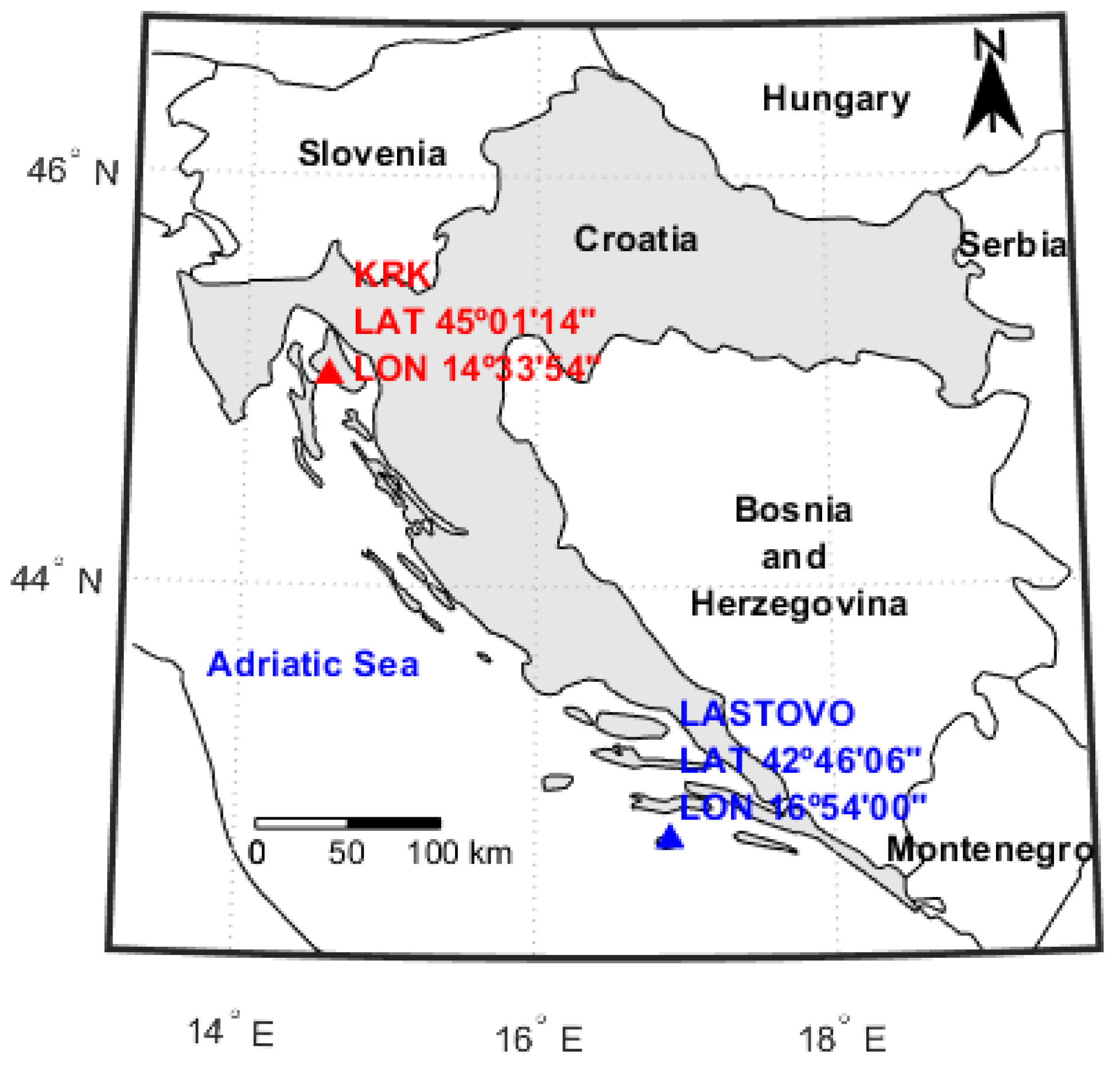


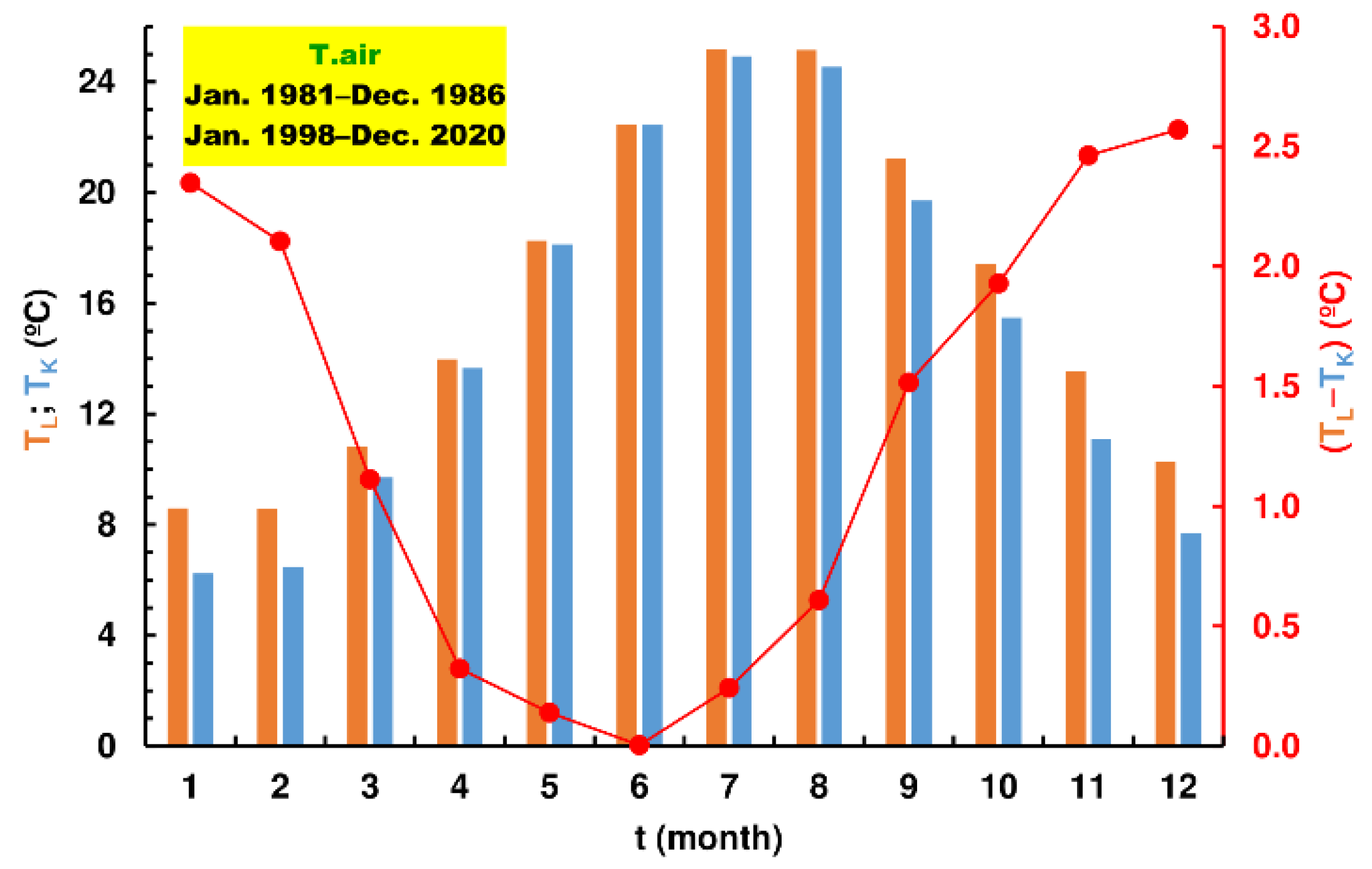
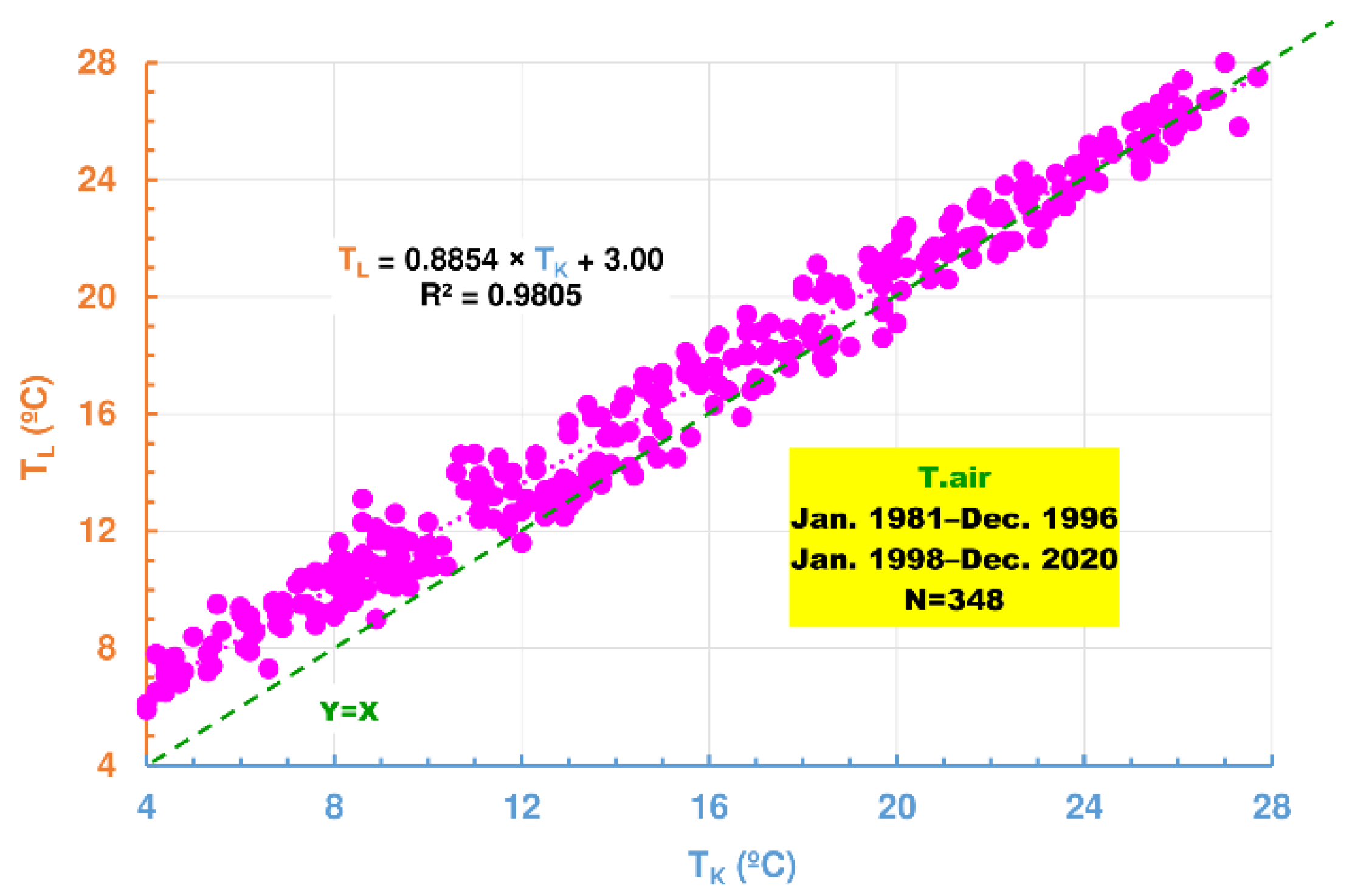
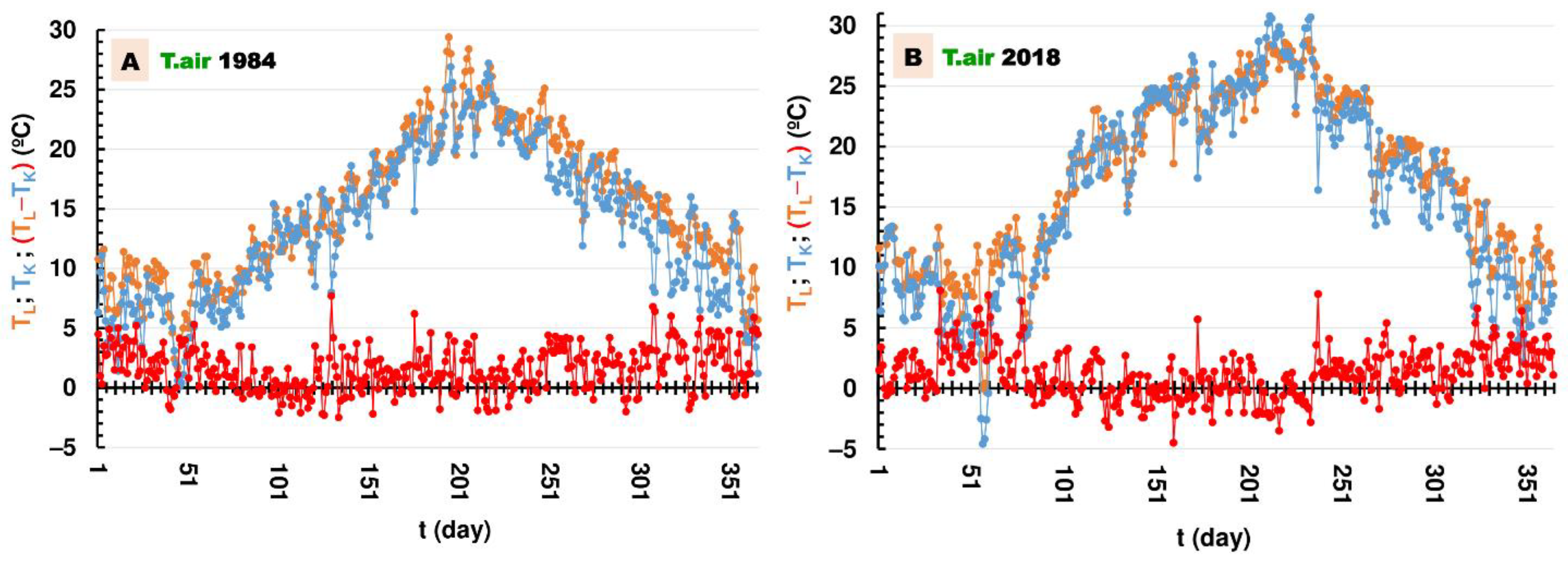
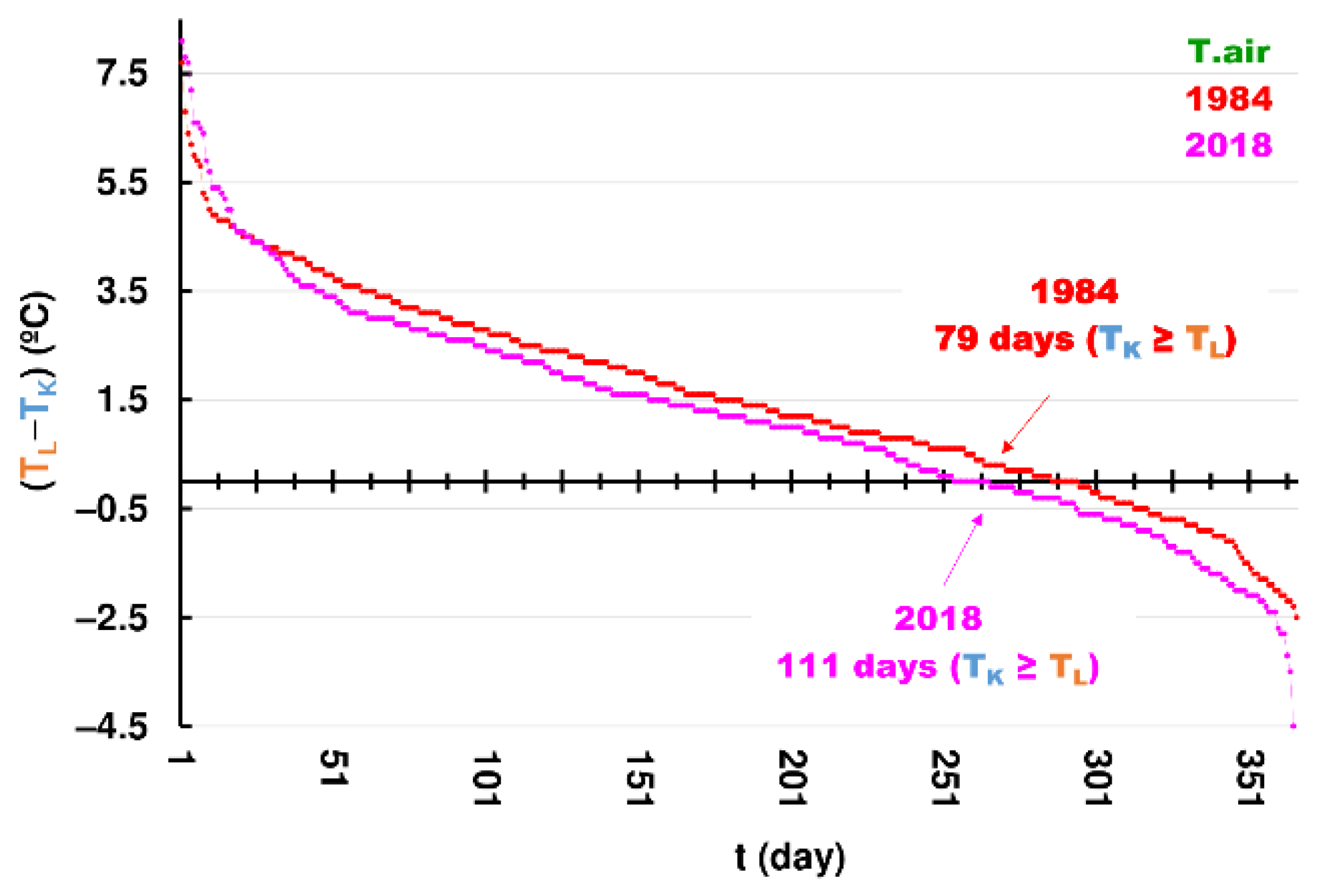

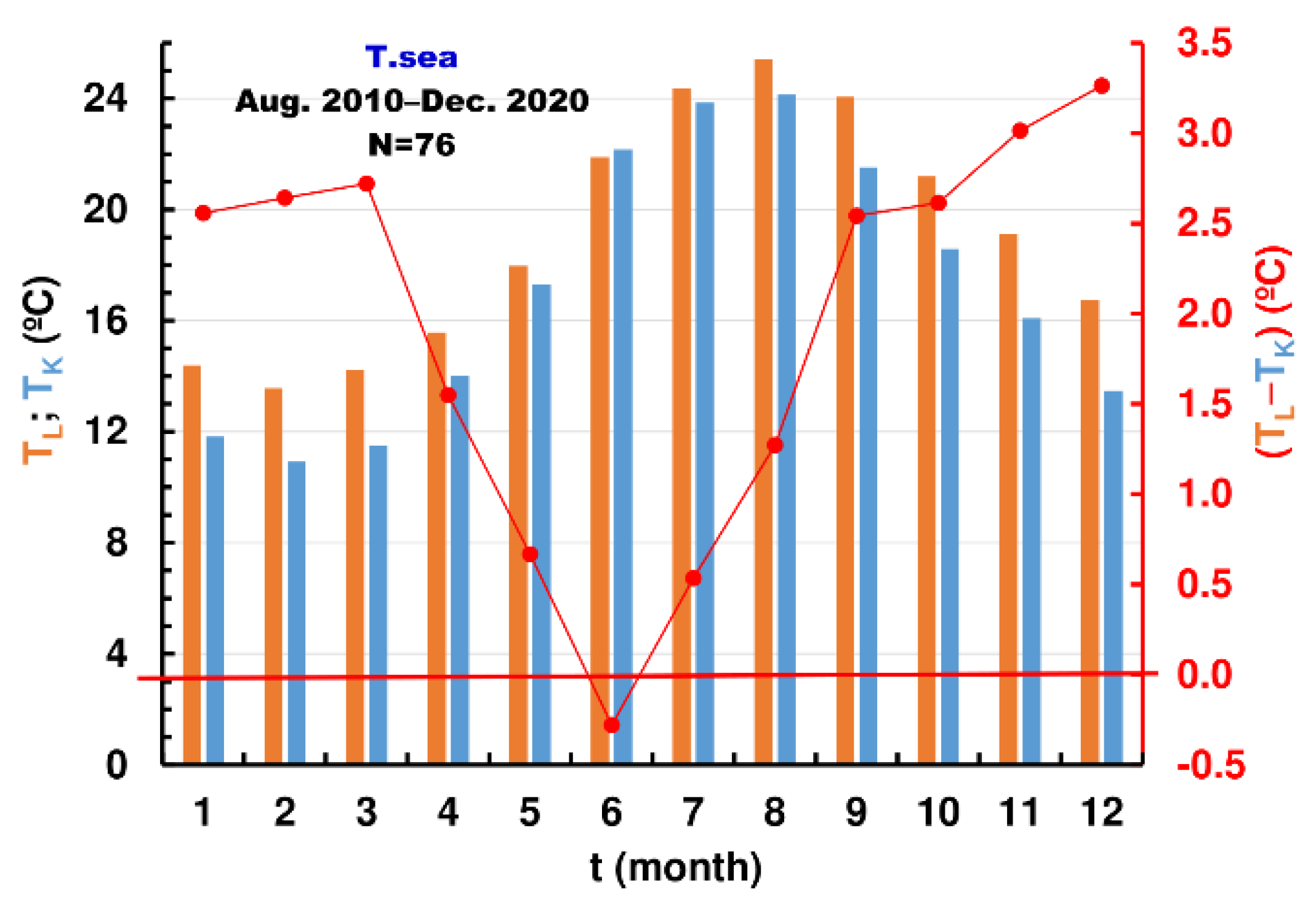
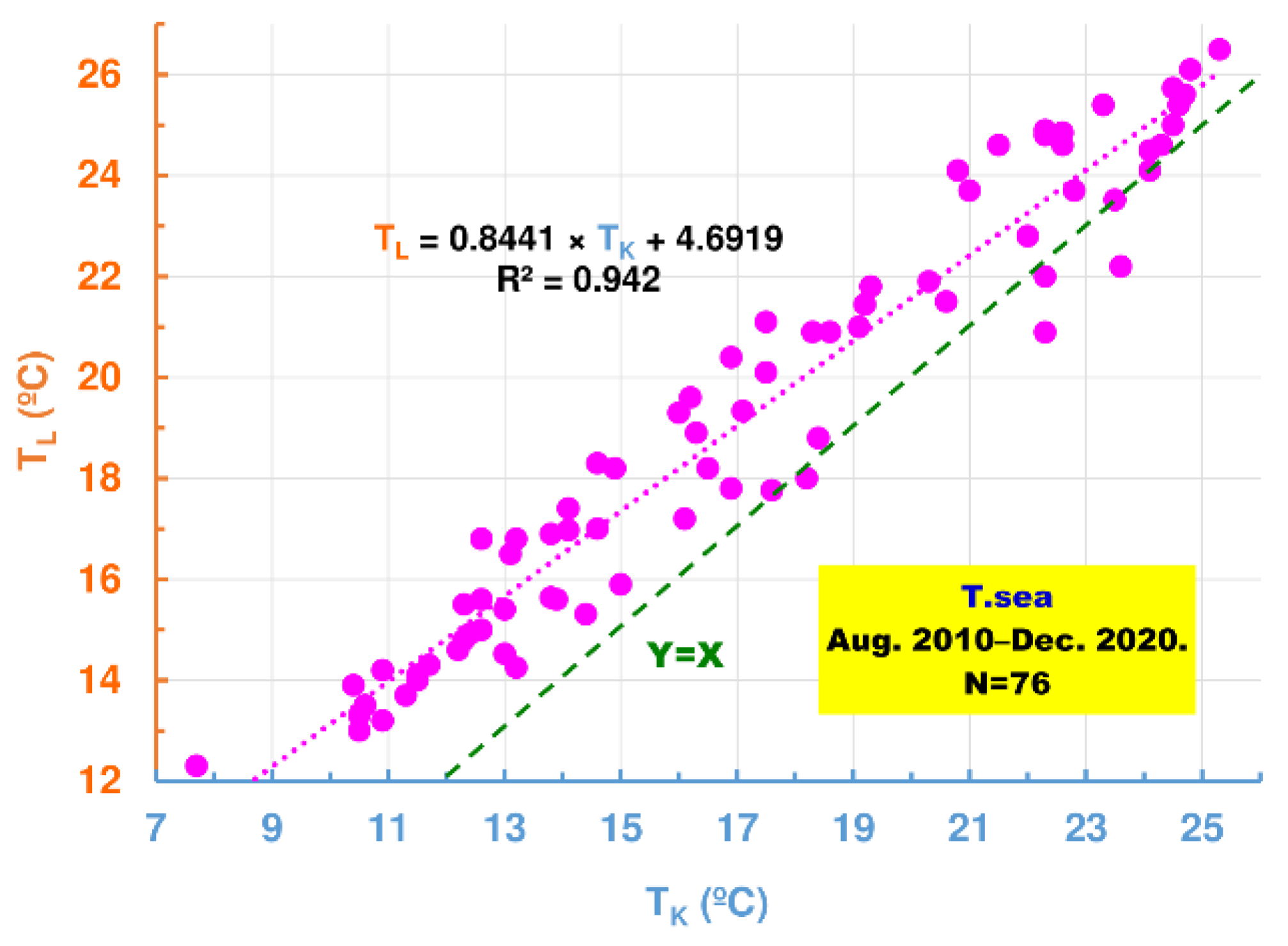
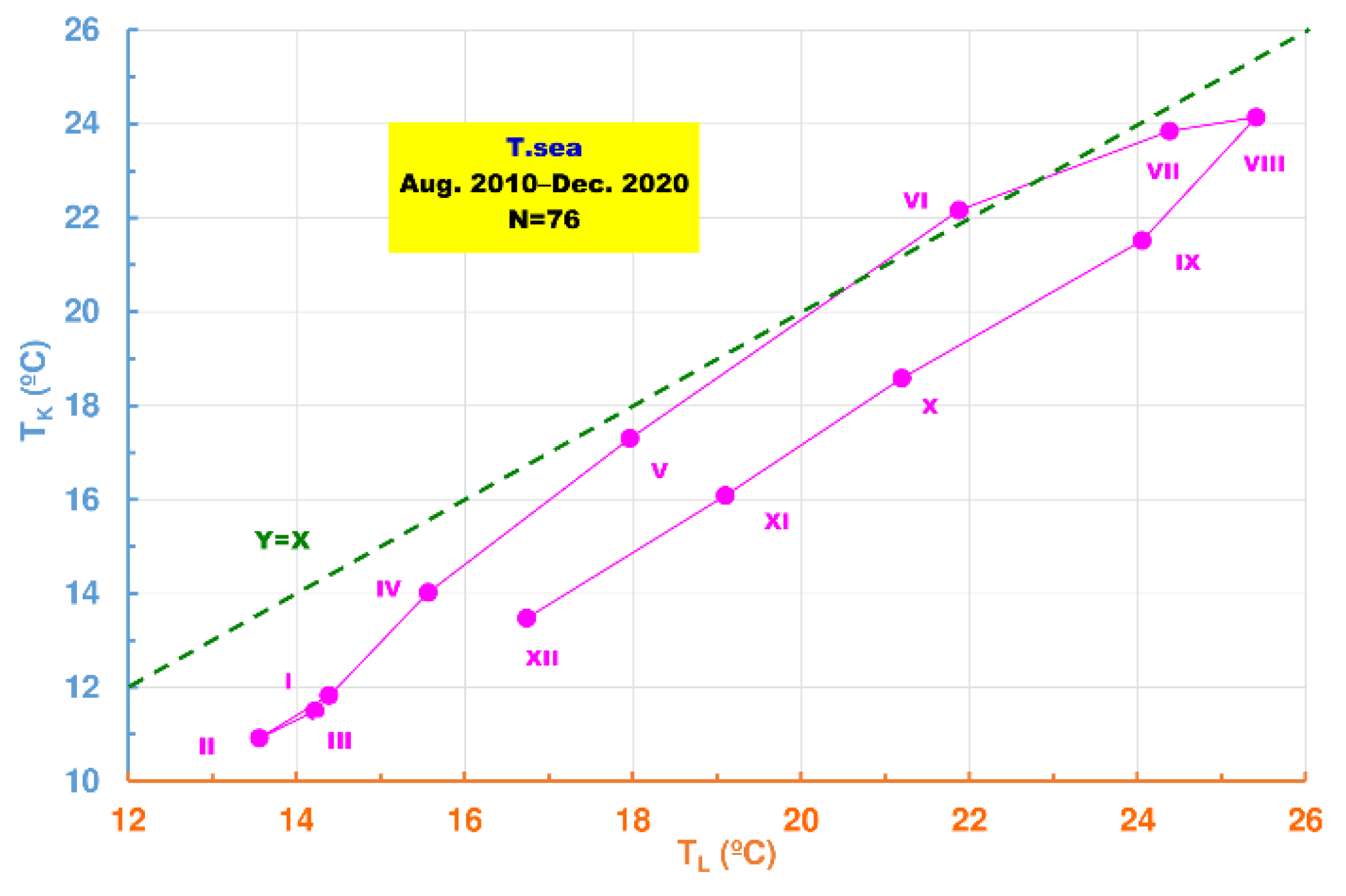
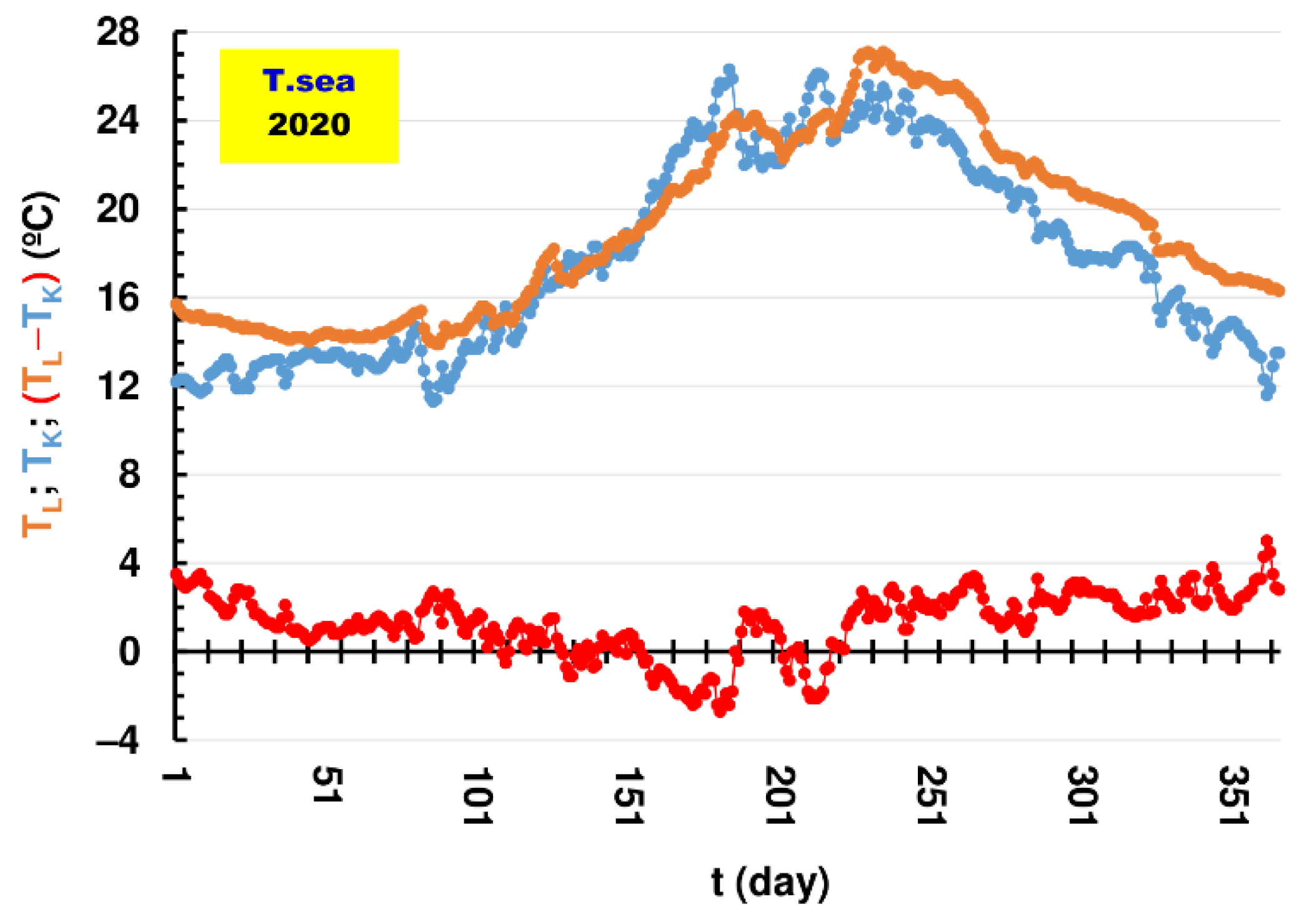
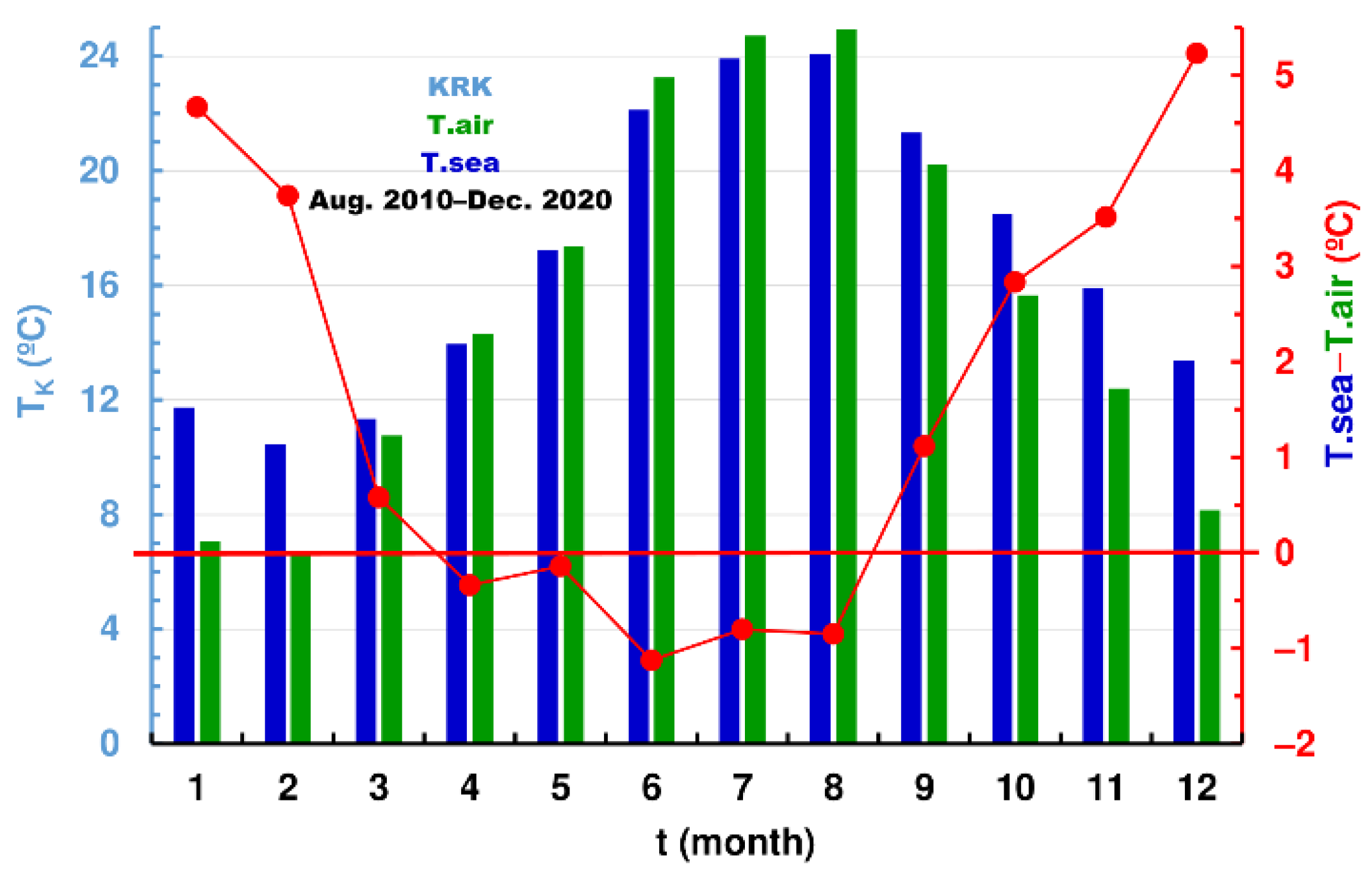
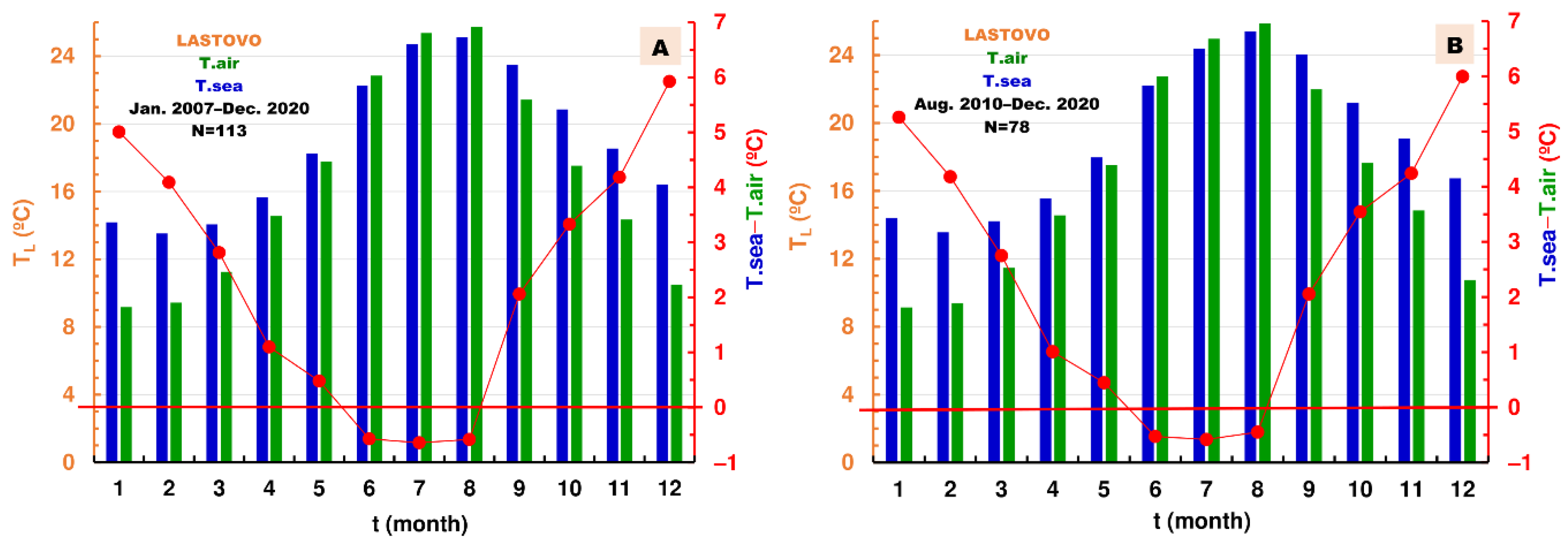
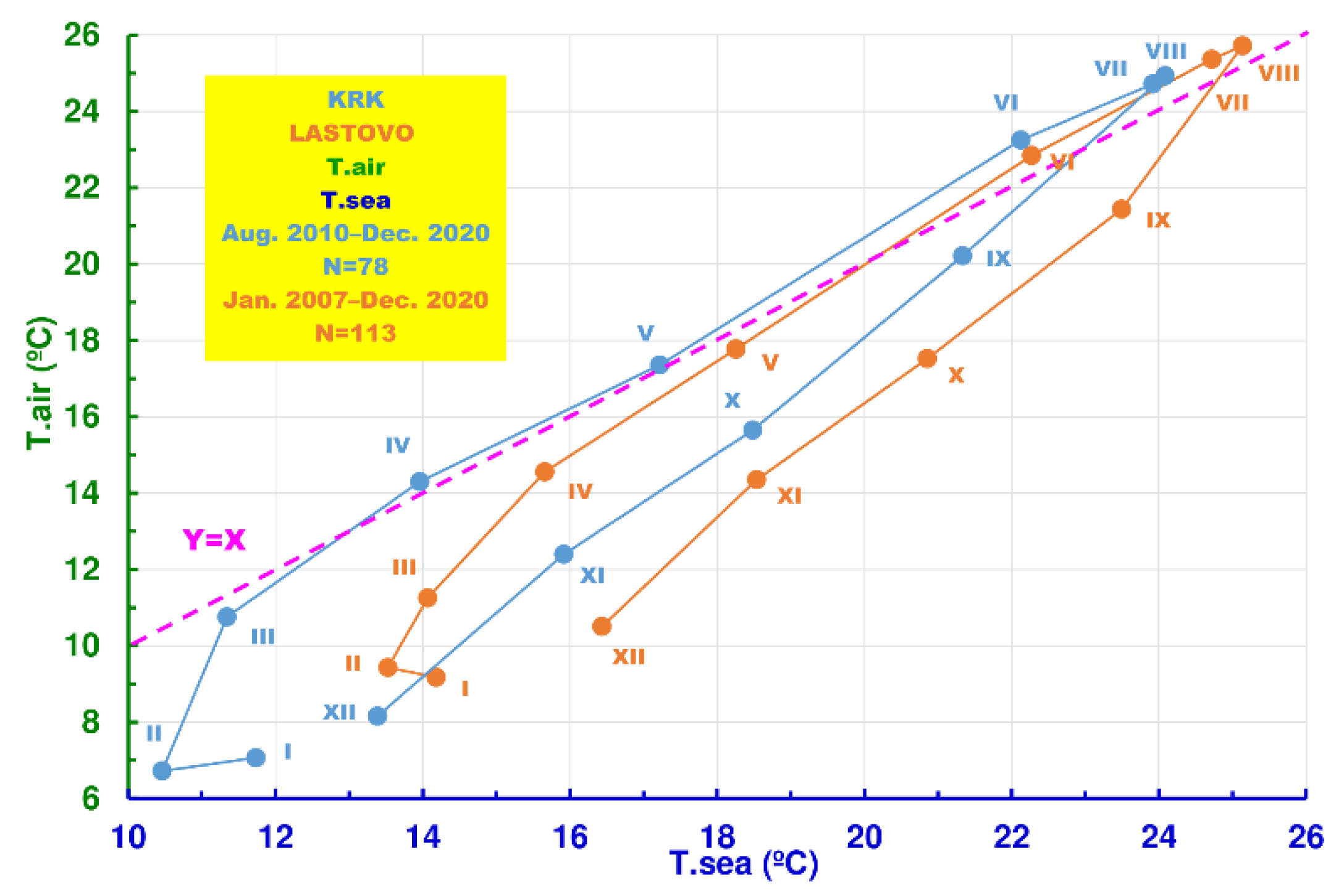
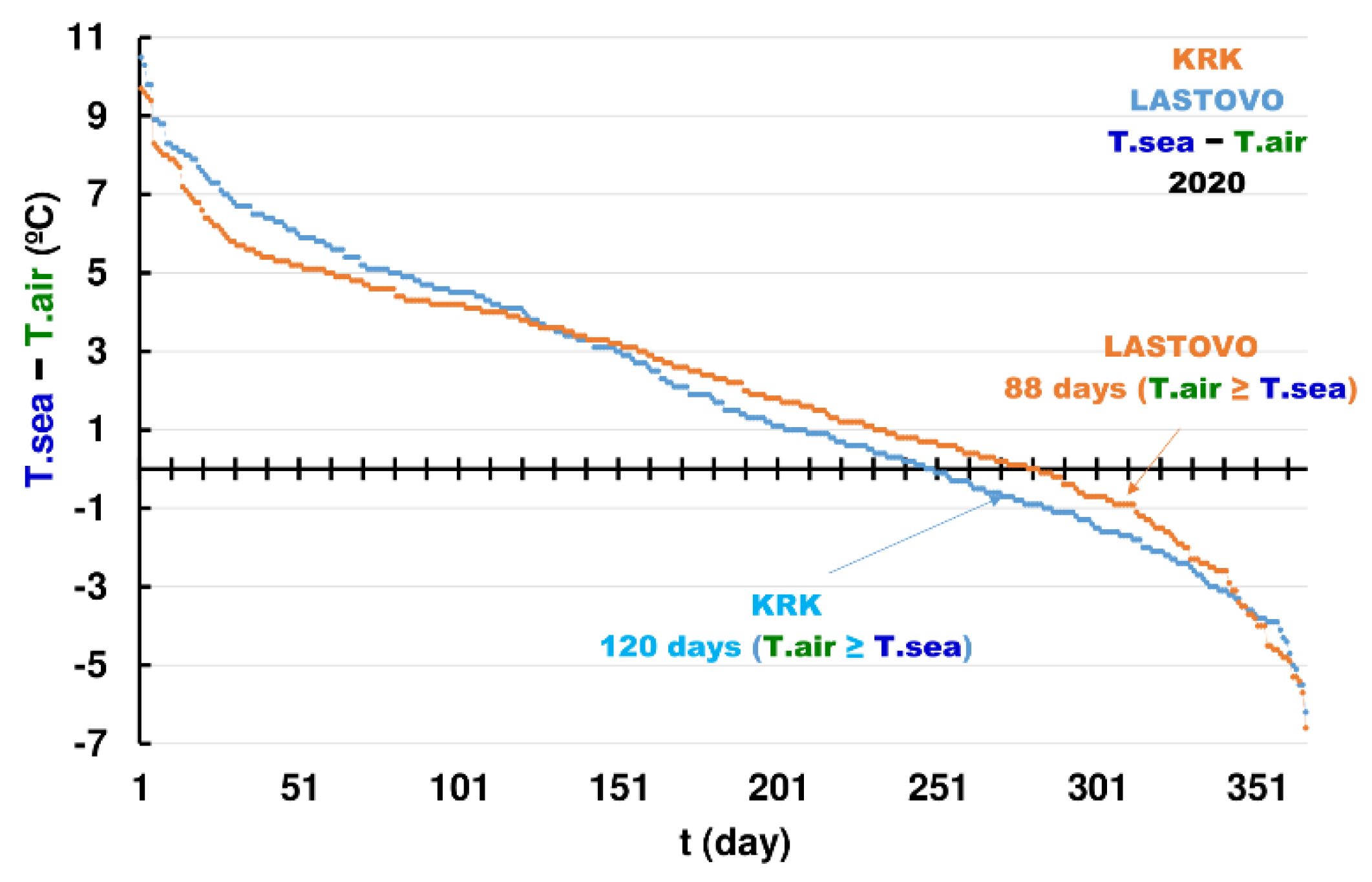
| Year | Krk Available Months | N | Lastovo Available Months | N |
|---|---|---|---|---|
| 2007 | - | 0 | I–XII | 12 |
| 2008 | - | 0 | I–XII | 12 |
| 2009 | - | 0 | - | 0 |
| 2010 | VIII–XII | 5 | I–XII | 12 |
| 2011 | I–XII | 12 | I–XII | 12 |
| 2012 | I–V; XI–XII | 7 | I–XII | 12 |
| 2013 | I–XII | 12 | I–XII | 12 |
| 2014 | I–XII | 12 | I–XII | 12 |
| 2015 | I | 1 | I | 1 |
| 2016 | - | 0 | - | 0 |
| 2017 | - | 0 | - | 0 |
| 2018 | VII–X; XII | 5 | VI–X; XII | 6 |
| 2019 | I–XII | 12 | I–II: V–XII | 10 |
| 2020 | I–XII | 12 | I–XII | 12 |
| Σ | 78 months | 113 months | ||
| Station | F-Test | t-Test | |
|---|---|---|---|
| MIN | Krk | 0.1062 | 9.8703 × 10−12 |
| Lastovo | |||
| MEAN | Krk | 0.3504 | 4.2878 × 10−10 |
| Lastovo | |||
| MAX | Krk | 0.6531 | 0.1549 |
| Lastovo |
| Station | Year | F-Test | t-Test |
|---|---|---|---|
| Krk | 1984 | 7.2478 × 10−6 | 1.0908 × 10−6 |
| 2018 | |||
| Lastovo | 1984 | 0.0077 | 1.5228 × 10−6 |
| 2018 |
| T. Sea (°C) | LASTOVO | KRK | Difference (Lastovo-Krk) |
|---|---|---|---|
| 2007 | 18.66 | - | - |
| 2008 | 18.73 | - | - |
| 2009 | - | - | - |
| 2010 | 18.28 | - | - |
| 2011 | 18.98 | 16.93 | 2.05 (1.08) |
| 2012 | 18.97 | - | - |
| 2013 | 19.04 | 16.76 | 2.28 (1.84) |
| 2014 | 19.46 | 17.59 | 1.87 (0.94) |
| 2015 | - | - | - |
| 2016 | - | - | - |
| 2017 | - | - | - |
| 2018 | - | - | - |
| 2019 | - | 17.76 | - |
| 2020 | 19.15 | 17.84 | 1.31 (1.19) |
Publisher’s Note: MDPI stays neutral with regard to jurisdictional claims in published maps and institutional affiliations. |
© 2022 by the authors. Licensee MDPI, Basel, Switzerland. This article is an open access article distributed under the terms and conditions of the Creative Commons Attribution (CC BY) license (https://creativecommons.org/licenses/by/4.0/).
Share and Cite
Bonacci, O.; Vrsalović, A. Differences in Air and Sea Surface Temperatures in the Northern and Southern Part of the Adriatic Sea. Atmosphere 2022, 13, 1158. https://doi.org/10.3390/atmos13071158
Bonacci O, Vrsalović A. Differences in Air and Sea Surface Temperatures in the Northern and Southern Part of the Adriatic Sea. Atmosphere. 2022; 13(7):1158. https://doi.org/10.3390/atmos13071158
Chicago/Turabian StyleBonacci, Ognjen, and Adrijana Vrsalović. 2022. "Differences in Air and Sea Surface Temperatures in the Northern and Southern Part of the Adriatic Sea" Atmosphere 13, no. 7: 1158. https://doi.org/10.3390/atmos13071158
APA StyleBonacci, O., & Vrsalović, A. (2022). Differences in Air and Sea Surface Temperatures in the Northern and Southern Part of the Adriatic Sea. Atmosphere, 13(7), 1158. https://doi.org/10.3390/atmos13071158







